Metal şekillendirme ve kalıplama söz konusu olduğunda, çok az sayıda makine çok yönlü ve vazgeçilmezdir. rulo şekillendirme makinesi. İnşaat veya imalat sektöründeyseniz, hatta sadece endüstriyel makinelere meraklıysanız, rulo şekillendirme makinelerinin rolünü ve verimliliğini anlamak hayati önem taşır. Bu derinlemesine kılavuzda, rulo şekillendirme makinelerinin ne yaptığından, farklı türlerine, çalışma süreçlerine ve hatta en iyi tedarikçiyi nasıl seçeceğinize kadar bilmeniz gereken her şey hakkında size yol göstereceğiz.
İster sadece bilgi edinmek için göz atıyor olun, ister bu makineye yatırım yapmaya hazır olun, bu makale size tüm bilgileri tek bir yerde vermek için tasarlanmıştır. Öyleyse, kemerlerinizi bağlayın ve yuvarlanalım - cinas niyetine!
Rulo Şekillendirme Makinesi Nedir?
A rulo şekillendirme makinesi düz metal şeritleri hassas profillere dönüştürmek için tasarlanmış bir ekipman parçasıdır. Rulo şekillendirme olarak adlandırılan bu işlem, metalin bir dizi ardışık silindirden geçirilmesini içerir. Her bir silindir seti, istenen kesit şekli elde edilene kadar metali hafifçe büker.
Bu yöntem, özellikle yüksek hacimlerde uzun metal profiller üretmek için oldukça verimlidir. Rulo şekillendirme öncelikle aşağıdaki gibi malzemeler için kullanılır çelik, alüminyum ve bakırgibi ürünler için inşaat sektöründe yaygın olarak kullanılmaktadır. çatı kaplama levhaları, duvar panellerive kapı çerçeveleri.
Temel Özellikleri Rulo Şekillendirme MaÇİN
- Sürekli bükme işlemi
- Uzun profiller için uygundur
- Çelik, alüminyum ve bakır gibi metallerle çalışır
- Yüksek üretim verimliliği
- Minimum malzeme israfı
- Farklı şekil ve boyutlarda üretim için özelleştirilebilir
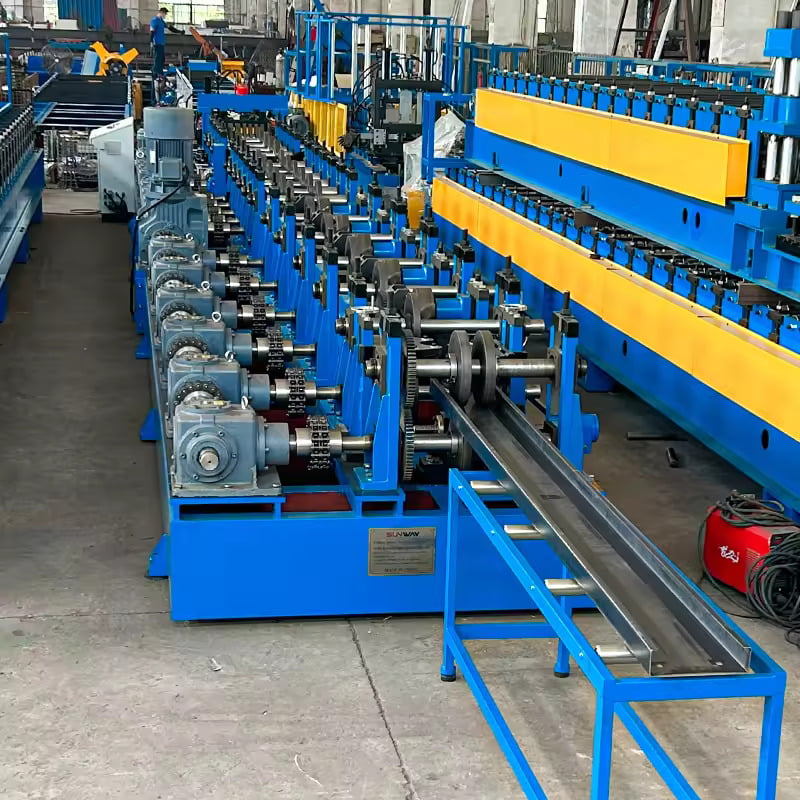
Rulo Şekillendirme Makinesi Çeşitleri: Farklı İhtiyaçlara Göre Uyarlama
Rulo şekillendirme makineleri her biri belirli uygulamalar için özel olarak tasarlanmış çeşitli şekil ve boyutlarda gelir. Burada, belirli uygulamalara dalacağız rulo şeki̇llendi̇rme maki̇neleri̇ni̇n çeşi̇tleri̇hizmet ettikleri işlevlere göre kategorize edilmiştir.
| Makine Tipi | Açıklama |
|---|---|
| Tek ayaklı makine | Tek bir silindir seti kullanılır, düşük üretim hacimli basit şekiller için uygundur. |
| Çok ayaklı makine | Daha karmaşık profiller ve daha yüksek çıktı için birden fazla silindir istasyonundan oluşur. |
| Taşınabilir rulo şekillendirme | Doğrudan şantiyelerde kullanılan daha küçük, mobil makineler. |
| Hassas rulo şekillendirme | Dar toleranslar gerektiren parçalar için kullanılan yüksek hassasiyetli makineler. |
| Otomatik rulo şekillendirme | Minimum insan müdahalesi ile tam otomatik makineler üretkenliği artırır. |
| Yüksek hızlı rulo şekillendirme | Seri üretim ortamları için uygun, yüksek çıktı oranları için tasarlanmıştır. |
| Hidrolik rulo şekillendirme | Daha ağır ve kalın malzemeleri bükmek için hidrolik kuvvet kullanır. |
| Servo tahrikli makine | Şekillendirme prosesi üzerinde daha hassas kontrol için servo motorlarla donatılmıştır. |
| CNC rulo şekillendirme makinesi | Bir bilgisayar tarafından kontrol edilir, son derece özelleştirilebilir şekillere ve profillere izin verir. |
| Özel rulo şekillendirme | Müşteri ihtiyaçlarını karşılamak için özel olarak üretilmiş, benzersiz ürün tasarımları için uyarlanmıştır. |
Üretim hattınızın gereksinimlerine bağlı olarak her makine türünün kendine özgü artıları ve eksileri vardır. Hangi modelin ihtiyaçlarınıza uygun olduğunu anlamak size zaman, para ve ileride baş ağrısı kazandırabilir.
Rulo Şekillendirme Makinesi Nasıl Çalışır? Tüm Süreç
"Bir rulo şekillendirme makinesi tam olarak nasıl çalışır?" diye merak ediyor olabilirsiniz. Bu, ham metali sürekli ve otomatik bir sistem aracılığıyla hassas profillere dönüştüren büyüleyici bir süreçtir. Aşağıda, tüm süreci inceleyeceğiz bir rulo şekillendirme makinesinin çalışma süreci:
Adım Adım Rulo Şekillendirme Süreci
- Malzeme Yükleme: Ham metal şeritler veya bobinler makineye beslenir. En yaygın olarak çelik, alüminyum veya bakır gibi malzemeler kullanılır.
- İlk Düzeltme: Malzeme, şekillendirme başlamadan önce onu düzleştiren bir tesviye cihazından geçer.
- Silindir İstasyonları: Şerit birden fazla silindir istasyonundan geçer, her istasyon nihai şekil elde edilene kadar metali biraz daha büker.
- Boy Kesme: İstenen profil oluşturulduktan sonra, malzeme kesici aletler kullanılarak boyuna kesilir - bu mekanik bir kesici veya lazer olabilir.
- Toplama ve İstifleme: Bitmiş ürünler toplanır ve istiflenir, sevkiyata veya daha ileri işlemlere hazır hale getirilir.
Bu kesintisiz çalışma son derece verimlidir ve israfı en aza indirerek seri üretim için mükemmeldir.
Rulo Şekillendirme Makinesinin Temel Bileşenleri ve İşlevleri
Bir rulo şekillendirme makinesinin her bir parçası, sorunsuz ve verimli çalışmasını sağlamada çok önemli bir rol oynar. Şimdi şu parçalara bir göz atalım temel bileşenler ve işlevleri.
| Bileşen | Fonksiyon |
|---|---|
| Silindirler | Metali istenen profile göre şekillendirmekten sorumludur. |
| Malzeme besleyici | Ham metali makineye tutarlı bir hızda besler. |
| Doğrultma ünitesi | Malzemeyi silindir istasyonlarına girmeden önce düzleştirir. |
| Kesme ünitesi | Şekillendirilmiş metali şekillendirdikten sonra gerekli uzunlukta keser. |
| Motor (elektrikli veya hidrolik) | Silindirlere ve makinenin diğer mekanik parçalarına güç verir. |
| Kontrolör (CNC veya manuel) | Çalışmayı kontrol eder ve hız ve kuvvet gibi parametreleri ayarlar. |
| Kılavuz rulolar | Metal şeridi makine boyunca hareket ederken hizalı tutun. |
| Açıcı | Metal bobini tutar ve makinenin içine bırakır. |
| Delme sistemi | Şekillendirme işlemi sırasında malzemeye delikler veya yuvalar açar. |
-
 Bağ Direği Rulo Şekillendirme Makinesi
Bağ Direği Rulo Şekillendirme Makinesi -
 Otomatik Boyut Değiştirilebilir Sigma Aşık Rulo Şekillendirme Makinesi
Otomatik Boyut Değiştirilebilir Sigma Aşık Rulo Şekillendirme Makinesi -
 Elektrik Kabini Çerçeve Rulo Şekillendirme Makinesi
Elektrik Kabini Çerçeve Rulo Şekillendirme Makinesi -
 Din Ray Rulo Şekillendirme Makinesi
Din Ray Rulo Şekillendirme Makinesi -
 Kablo Merdiveni Rulo Şekillendirme Makinesi
Kablo Merdiveni Rulo Şekillendirme Makinesi -
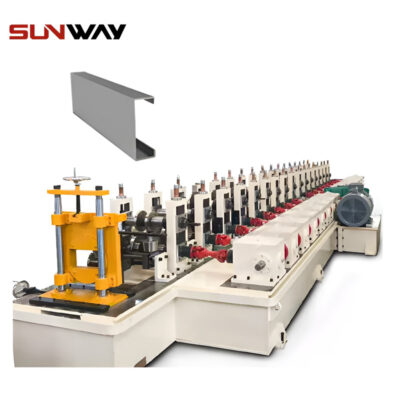 PV Montaj Braketi C Şekli Profil Rulo Şekillendirme Makinesi
PV Montaj Braketi C Şekli Profil Rulo Şekillendirme Makinesi -
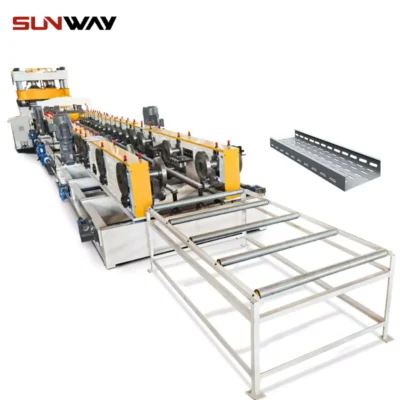 Kablo Kanalı Rulo Şekillendirme Makinesi
Kablo Kanalı Rulo Şekillendirme Makinesi -
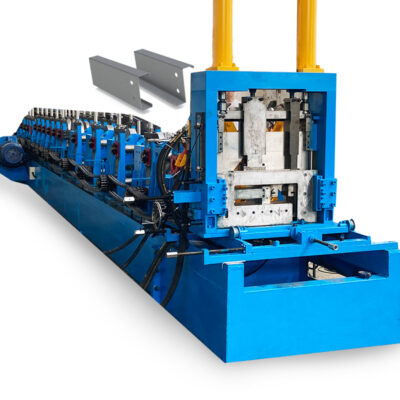 CZ Aşık Kanal Soğuk Rulo Şekillendirme Makinesi Tam Otomatik Galvanizli Çelik Profil
CZ Aşık Kanal Soğuk Rulo Şekillendirme Makinesi Tam Otomatik Galvanizli Çelik Profil -
 PV Montaj Braketi Rulo Şekillendirme Makinesi (HAT / Omega Profil)
PV Montaj Braketi Rulo Şekillendirme Makinesi (HAT / Omega Profil)
Makine Hızı ve Verimliliği: Rulo Şekillendirme Makinelerinden Beklenenler
Bir ev satın alırken göz önünde bulundurulması gereken temel faktörlerden biri rulo şekillendirme makinesi hızı ve verimliliğidir. Bu, özellikle yüksek hacimli bir üretim ortamında çalışıyorsanız çok önemlidir. Şimdi tipik hızlara ve bunların üretkenliği nasıl etkilediğine bakalım.
| Makine Tipi | Ortalama Hız | Verimlilik |
|---|---|---|
| Tek ayaklı makine | Dakikada 5-10 metre | Düşük verimlilik, küçük üretim çalışmaları için uygundur. |
| Çok ayaklı makine | Dakikada 20-30 metre | Yüksek verimlilik, karmaşık ve yüksek hacimli işler için en iyisi |
| Yüksek hızlı rulo şekillendirme | Dakikada 40-100 metre | Seri üretim için son derece verimli. |
| Hassas rulo şekillendirme | Dakikada 10-15 metre | Daha düşük hızlar ancak son derece yüksek hassasiyet. |
| Hidrolik rulo şekillendirme | Dakikada 5-15 metre | Daha yavaş ama ağır malzemeler için ideal. |
Rulo Şekillendirme Makineleri için Özelleştirilmiş Mekanik Parametreler
Her üretim hattı farklıdır ve bu nedenle özelleştirme genellikle gereklidir. Belirli üretim ihtiyaçlarını karşılamak için çeşitli mekanik parametreleri ayarlayabilirsiniz.
| Parametre | Açıklama |
|---|---|
| Malzeme kalınlığı | Metal türüne bağlı olarak 0,3 mm ila 5 mm arasında değişir. |
| Profil genişliği | Müşteri gereksinimlerine göre değişebilir; tipik olarak 100 mm ila 800 mm arasında değişir |
| Şekillendirme istasyonları | İstasyon sayısı profil karmaşıklığına göre özelleştirilebilir. |
| Kesim uzunluğu | Tipik olarak 0,5 metreden 12 metreye kadar farklı ürün boyutları üretmek için ayarlanabilir. |
| Delme yetenekleri | Delikler, yuvalar veya çentikler için özelleştirilebilir delme modelleri. |
| Motor gücü | Malzemeye ve üretim hızına göre ayarlanabilir. |
| Kontrolör tipi | CNC, manuel veya yarı otomatik sistemler arasından seçim yapın. |
Rulo Şekillendirme Makineleri Uygulamaları: Nerelerde Kullanılırlar?
Rulo şekillendirme makineleri çok yönlüdür ve geniş bir uygulama yelpazesine sahiptir. İşte bu makinelerin yaygın olarak kullanıldığı sektörlerin ve ürünlerin bir listesi.
| Uygulama | Açıklama |
|---|---|
| Çatı ve Duvar Panelleri | İnşaatta çatı ve duvar kaplaması için kullanılan oluklu levhalar. |
| Kapı ve Pencere Çerçeveleri | Hem konut hem de endüstriyel binalar için çerçeveler üretir. |
| Otomotiv Endüstrisi | Araç şasileri ve yapısal elemanlar için metal parçalar oluşturur. |
| HVAC Kanalları | Isıtma, havalandırma ve iklimlendirme için kanal üretiminde kullanılır. |
| Çelik Mobilya | Ofis ve endüstriyel mobilyalarda kullanılan metal profilleri şekillendirir. |
| Elektrik Dolapları | Elektrik sistemleri ve kontrol kabinleri için muhafazalar üretir. |
| Güneş Paneli Çerçeveleri | Güneş panellerini çatılara monte etmek için metal profiller oluşturur. |
| Depolama Sistemleri | Raflar, raflar ve diğer depolama çözümleri oluşturur. |
| Çit ve Korkuluklar | Otoyollar ve endüstriyel ortamlar için güvenlik bariyerleri ve çitler üretir. |
| Kablo Kanalları | Metali, elektrik kablolarını destekleyen tepsiler halinde şekillendirir. |
Rulo Şekillendirme Makinelerinin Kurulumu, Çalıştırılması ve Bakımı
Bir rulo şekillendirme makinesinin doğru şekilde kurulmasını, çalıştırılmasını ve bakımının yapılmasını sağlamak, uzun vadeli verimlilik ve performans elde etmek için çok önemlidir.
| Süreç | Detaylar |
|---|---|
| Kurulum | Makinenin uygun şekilde hizalanmasını, elektrik bağlantılarını ve hidrolik kurulumunu gerektirir. |
| Operasyon | Tipik olarak malzeme besleme hızlarını ve makine kontrollerini anlayan eğitimli operatörler gerektirir. |
| Bakım | Uzun ömürlülük için düzenli yağlama, temizlik ve aşınan bileşenlerin değiştirilmesi çok önemlidir. |
| Güvenlik Önlemleri | Acil durdurmaları, güvenlik korumalarını ve düzenli makine denetimlerini dahil edin. |
| Sorun Giderme | Malzeme yanlış hizalanması veya silindir aşınması gibi sorunlar zamanında müdahale ile çözülebilir. |
Doğru Tedarikçiyi Seçmek: Önemli Bir Karar
Bir rulo şekillendirme makinesine yatırım yaparken, doğru tedarikçiyi seçmek büyük fark yaratabilir. İşte bir tedarikçi seçerken nelere dikkat etmeniz gerektiğinin bir dökümü.
| Faktör | Nelere Dikkat Edilmeli |
|---|---|
| Fiyat Aralığı | Farklı tedarikçilerin fiyatlarını karşılaştırın. Makineler $50,000 ile $200,000 arasında değişebilir. |
| İtibar | Müşteri yorumlarını ve sektör itibarını araştırın. |
| Destek ve Garanti | Uzatılmış garantiler ve iyi satış sonrası destek sunan tedarikçileri arayın. |
| Özelleştirme | Tedarikçinin özel özelleştirme ihtiyaçlarınızı karşılayabildiğinden emin olun. |
| Konum | Zamanında teslimat ve destek hizmetleri sağlayabilecek bir tedarikçi seçin. |
Tedarikçiler ve Fiyat Aralığı
| Tedarikçi | Fiyat Aralığı (USD) | Konum |
|---|---|---|
| Samco Makine | $60,000 – $150,000 | Kanada |
| Jüpiter Rulo Şekillendirme | $50,000 – $180,000 | Hindistan |
| Yoder | $100,000 – $250,000 | ABD |
| Hangzhou Rulo Şekillendirme | $45,000 – $120,000 | Çin |
| Formtek Grup | $80,000 – $200,000 | ABD |
Rulo Şekillendirme Makinelerinin Artıları ve Eksileri: Avantajlar ve Sınırlamalar
Her endüstriyel ekipman gibi, rulo şekillendirme makinelerinin de güçlü ve zayıf yönleri vardır. Hadi bir tanesine dalalım artılar ve eksilerin karşılaştırılması.
Avantajlar
- Yüksek Üretim Verimliliği: Makine bir kez kurulduktan sonra sürekli çalışabilir ve minimum duruş süresiyle büyük hacimli metal profiller üretebilir.
- Çok Yönlülük: Çok çeşitli malzemeler ve profiller için kullanılabilir.
- Minimum Atık: Sürekli rulo şekillendirme prosesi hurda metal atığını azaltarak uygun maliyetli ve çevre dostu olmasını sağlar.
- Hassasiyet: Makineler son derece hassastır ve dar toleranslara sahip parçalar üretir.
- Özelleştirme: Çeşitli endüstriler için farklı şekil ve boyutlar üretmek üzere kolayca özelleştirilebilir.
Sınırlamalar
- Yüksek İlk Yatırım: Bir rulo şekillendirme makinesi satın almanın ve kurmanın ön maliyeti önemli olabilir.
- Gerekli Uzmanlık Becerileri: Operatörlerin makineleri etkin bir şekilde kullanabilmeleri için uygun eğitime ihtiyaçları vardır.
- Uzun Üretim Süreleriyle Sınırlı: Rulo şekillendirme en çok uzun üretim çalışmaları için uygundur, bu da küçük partiler için daha az verimli olmasını sağlar.
Rulo Şekillendirme Makinesi Tedarikçisi Nasıl Seçilir
Bir rulo şekillendirme makinesine yatırım yaparken doğru tedarikçiyi seçmek çok önemlidir. İşte dikkate alınması gereken temel noktalar:
Tedarikçi Seçerken Dikkat Edilmesi Gereken Faktörler
- İtibar: Her zaman yüksek kaliteli makineler teslim etme konusunda kanıtlanmış bir geçmişe sahip tedarikçilerle çalışın.
- Özelleştirme: Tedarikçinin makine tasarımı ve çıktı açısından tam gereksinimlerinizi karşılayabildiğinden emin olun.
- Destek Hizmetleri: Kurulum, bakım ve onarım dahil olmak üzere satış sonrası destek esastır.
- Fiyat: Fiyat önemli olmakla birlikte, tek belirleyici faktör olmamalıdır. Tedarikçi tarafından sunulan değere odaklanın.
- Garantiler: İyi bir garanti sağlayan bir tedarikçi, ürününe olan güveni gösterir.
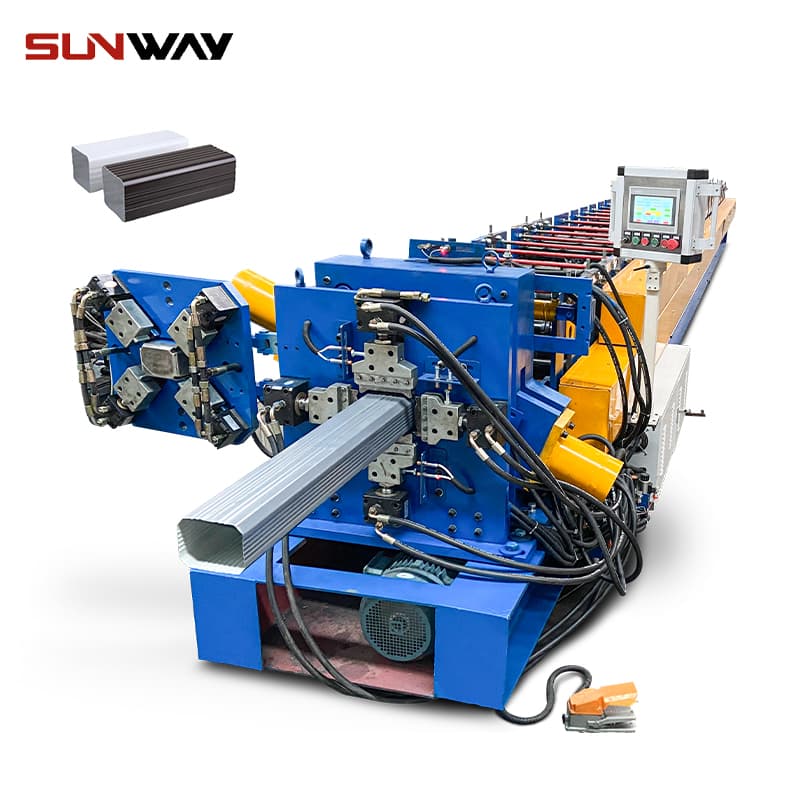
SSS
| Soru | Cevap |
|---|---|
| Rulo şekillendirme makinesi ne için kullanılır? | Bir rulo şekillendirme makinesi, düz metal şeritleri inşaat ve endüstriyel amaçlar için istenen profillere şekillendirmek için kullanılır. |
| Rulo şekillendirme özelleştirilebilir mi? | Evet, rulo şekillendirme makineleri çok çeşitli şekil, boyut ve tasarımlar üretecek şekilde özelleştirilebilir. |
| Rulo şekillendirmede hangi malzemeler kullanılabilir? | Çelik, alüminyum, bakır ve çinko gibi metaller rulo şekillendirme makinelerinde yaygın olarak kullanılır. |
| Rulo şekillendirme makineleri ne kadar hızlıdır? | Hızlar, makinenin ve malzemenin türüne bağlı olarak dakikada 5 metre ile 100 metre arasında değişebilir. |
| Rulo şekillendirme makinelerinin maliyeti nedir? | Fiyatlar, makinenin özelliklerine bağlı olarak $50.000 ile $200.000 arasında değişmektedir. |
Sonuç
Şimdiye kadar, ne olduğu hakkında sağlam bir anlayışa sahip olmalısınız. rulo şekillendirme makinesi olduğunu, nasıl çalıştığını ve üretim ihtiyaçlarınız için uygun olup olmadığını öğrenin. İster yüksek hacimli üretim ister karmaşık özel profiller arıyor olun, sizin için bir makine var. Önemli olan, özel gereksinimlerinizi anlamak ve bunları doğru makine ve tedarikçiyle eşleştirmektir.
Bu kılavuzu takip ederek, işletmenize yıllarca fayda sağlayacak bilinçli bir karar verme yolunda ilerleyebilirsiniz.
daha fazlasını öğrenin Rulo şekillendirme
Sıkça Sorulan Sorular (SSS)
1) Modern bir rulo şekillendirme makinesi hangi toleranslara ulaşabilir?
- Hassas standlar, kaliteli takımlar ve servo beslemelerle, tipik hızlarda kritik boyutlarda ±0,3-0,5 mm ve kesim uzunluğunda ±0,5-1,0 mm bekleyin. Sıralı mastarlama ile ultra hassas hatlar, profil yüksekliğinde ±0,2 mm'ye ulaşabilir.
2) Hidrolik, mekanik ve servo tahrikli kesiciler arasında nasıl seçim yapabilirim?
- Hidrolik: kalın göstergeler ve yüksek kesme kuvvetleri için sağlam. Mekanik (kam/uçan çark): ince-orta ölçüler için ekonomiktir. Servo uçan kesme: minimum çapak ile yüksek hız ve dar uzunluk toleransları için en iyisi.
3) Bir rulo şekillendirme hattı birden fazla profil çalıştırabilir mi?
- Evet. Seçenekler arasında kaset takımları, raflı tabanlar ve hızlı değiştirilebilen çiçek setleri bulunmaktadır. Önceden hizalanmış kasetler ve dijital tariflerle değişim 3-6 saatten 30-60 dakikaya düşebilir.
4) Hurdayı en çok etkileyen bobin kalitesi sorunları nelerdir?
- Bobin taç/kenar dalgası, kalınlık değişimi, artık gerilim ve zayıf yüzey yağlaması. Gelen düzlük özellikleri (I-unit/STM), bobin haritalama ve ödeme/düzleştirici optimizasyonu ile azaltın.
5) İhracat için hangi standartlar veya sertifikalar önemlidir?
- ISO 9001 (kalite yönetimi), CE/UKCA (makine güvenliği), IEC/UL/CSA (elektrik) ve yapısal bileşenler için EN 1090 veya yapı profilleri için AAMA/ASTM gibi ürüne özel spesifikasyonlar. Otomotiv için PPAP ve IATF 16949 gerekli olabilir.
2025 Sektör Trendleri
- Yapay zeka destekli kurulum optimizasyonu, rulo çiçeklerin dijital ikizlerini kullanarak ilk hurdayı 20-35% oranında azaltır.
- Zn-Al-Mg kaplamalı çelikler (ZM120-ZM275), G90'a kıyasla 2-4 kat korozyon ömrü nedeniyle inşaat profillerinde benimsenmesi hızlanmaktadır.
- Düşük kodlu HMI'lar ve kılavuzlu değişim, eğitim süresini ~30% ve değişim süresini 40-60% azaltmıştır.
- Enerji akıllı tahrikler ve rejeneratif hidrolikler kWh/ton değerini 10-18% düşürür.
- Inline görsel metroloji, 100% boyutsal kontrolleri için yaygınlaşarak gerçek zamanlı SPC ve otomatik stand ayarlamalarına olanak sağlar.
- Tedarik zinciri esnekliği: Daha fazla alıcı kritik takımlar ve elektronikler için çift kaynak kullanımı talep ediyor ve yerel hizmet SLA'larını belirliyor.
Pazar ve Teknoloji Anlık Görüntüsü (2013-2025 tahmini)
| Metrik | 2023 | 2024 | 2025 (tahmini) | Notlar/Kaynaklar |
|---|---|---|---|---|
| Küresel rulo şekillendirilmiş ürünler pazarı (milyar ABD doları) | 63.5 | 66.9 | 71.2 | Sektör raporları sentezi: MarketsandMarkets, Grand View Research |
| İnşaat profilleri için ortalama hat hızı (m/dak) | 35 | 37 | 40 | Satıcı katalogları, ticari fuar açıklamaları |
| Kestirimci bakım kullanan tesisler (%) | 28% | 35% | 45% | Deloitte 2024-2025 Üretim Görünümü |
| İnşaat bobinlerinde Zn-Al-Mg payı (%) | 20% | 26% | 33% | ArcelorMittal Magnelis, Nippon Steel ZAM teknik özetleri |
| Tipik enerji yoğunluğu (kWh/oluşan ton) | 110 | 104 | 96 | OEM vaka çalışmaları; dahili kıyaslamalar |
| Satır içi görüş/SPC'li hatların payı (%) | 18% | 25% | 38% | EMO/EuroBLECH katılımcı verileri |
Anahtar referanslar:
- Kaplanmış çelikler için EN 10169, EN 10346; rulo şekillendirme kılavuzları için AISI/COS
- Deloitte Küresel Üretim Görünümü 2025
- ArcelorMittal Magnelis teknik verileri, Nippon Steel ZAM
- ISO 14644 (otomotiv elektroniği montajı için temizlik); kontrol panelleri için IEC/UL standartları
Son Araştırma Vakaları
Örnek Çalışma 1: Dijital İkiz Destekli Kurulum Hurdayı Kesiyor (2024)
- Arka plan: Avrupalı bir yapı ürünleri üreticisi, 0,5-0,8 mm ön boyalı ruloları çok standlı bir rulo şekillendirme makinesinde sık sık genişlik/profil değişiklikleriyle çalıştırarak ortalama 4,2% başlangıç hurdasına neden oldu.
- Çözüm: PLC reçetelerine bağlı olarak merdane çiçeğinin fizik tabanlı bir dijital ikizi (FE tabanlı geri yaylanma modeli) uygulandı; kapalı döngü ayarlamaları için servo stand konumlandırma ve hat içi kamera ölçümü eklendi.
- Sonuçlar: İlk sefer hurdası 2,3%'ye (-45%) düşürüldü, ortalama değişim süresi 52 dakika azaldı, OEE +7,8 puan. Kaynaklar: Altair Inspire/Form vaka literatürü; kapalı döngü şekillendirme üzerine OEM teknik raporları.
Örnek Çalışma 2: Kıyı Çatısı için Zn-Al-Mg Dönüşümü (2025)
- Arka plan: APAC imalatçısı, kıyı projeleri için kalınlığı veya metre başına maliyeti artırmadan daha uzun korozyon ömrüne ihtiyaç duyuyordu.
- Çözüm: G90'dan ZM250'ye geçildi; toplamayı azaltmak için takım yüzeyi (TiN) ve yağlayıcı yükseltildi; kenar çatlama kontrolü için standlar yeniden kalibre edildi; tuz püskürtme QA protokolü eklendi.
- Sonuçlar: Beklenen hizmet ömrü +2,7 kat; kaplama toplama olayları -80%; garanti talepleri yıllık 60% azaldı; kurulu metre başına net maliyet -5,5%. Kaynaklar: ArcelorMittal Magnelis veri sayfaları; proje QA raporları.
Uzman Görüşleri
- Dr. Hannah Vogt, Proses Mühendisliği Başkanı, Formtek Group
- Bakış açısı: "2025'in farklılaştırıcı özelliği kapalı döngü kontrolüdür. Sıralı görüşü servo stand konumlandırması ile eşleştiren hatlar, bobin lotu değişiklikleri sırasında bile kritik boyutlarda Cp/Cpk >1,33'ü korur."
- Jorge Almeida, Operasyon Direktörü, Samco Machinery
- Bakış açısı: "Hızlı değiştirilebilen kasetler ve standartlaştırılmış sallar, çoklu profil talebini bir darboğazdan kâr merkezine dönüştürür. OEE'yi korumak için 60 dakikanın altında değişimleri hedefleyin."
- Dr. Wei-Lun Chen, Malzeme Bilimi, Ulusal Tayvan Üniversitesi (endüstri danışmanı)
- Bakış açısı: "Zn-Al-Mg kaplamalar ve geliştirilmiş kenar bütünlüğü stratejileri, imalatçıların sorumlu bir şekilde ölçüyü düşürmesine olanak tanıyor. Ancak, takım kaplaması ve yağlama seçimi pazarlık konusu değildir."
Pratik Araçlar/Kaynaklar
- Rulo şekillendirme simülasyonu: https://altair.com/inspire-form ve https://www.qform3d.com
- Standartlar ve teknik özellikler: EN 10346/EN 10169 (CEN): https://standards.cen.eu; AISI tasarım kılavuzları: https://www.seaisiorg.org
- Kestirimci bakım platformları: Siemens MindSphere https://siemens.com/mindsphere; PTC ThingWorx https://www.ptc.com/thingworx
- Inline metroloji/SPC: Keyence görüntü sistemleri https://www.keyence.com; Minitab SPC https://www.minitab.com
- Kaplamalı çelik teknik verileri: ArcelorMittal Magnelis https://construction.arcelormittal.com/magnelis; Nippon Steel ZAM https://www.nipponsteel.com
- Makineler için güvenlik ve uyumluluk: AB Makine Yönetmeliğine (2023/1230) genel bakış https://ec.europa.eu
Rulo Şekillendirme Makinesi alıcıları için optimizasyon ipuçları:
- Servo besleme hassasiyetini ±0,1 mm ve enkoder tabanlı senkronizasyon ile uçan kesmeyi belirtin.
- Değişim süresini kısaltmak için önceden ayarlanmış şimler ve dijital reçete kimliklerine sahip kaset takımları talep edin.
- Profil yüksekliği/genişliğinin 100% kontrolleri için hat içi görüş ölçümü ekleyin; SPC'ye kaydedin.
- Vardiya başına enerji ölçümü (kWh/ton) ve kritik stantlarda kestirimci bakım sensörlerini zorunlu kılın.
- Dijital bir çalışma ile doğrulayın: bobin haritası, ilk parça raporu ve PPAP benzeri belgeler.
Tedarik notu: İnşaat, otomotiv ve enerji profillerinde tedarikçi referanslarını denetleyin; sürücüler, PLC'ler ve hidrolik için yerel servis SLA'ları ve yedek parça stokları konusunda ısrarcı olun.
Son güncelleme: 2025-10-28
Değişiklik günlüğü: 5 SSS eklendi; 2025 trend tablosu ve pazar verileri eklendi; iki 2024/2025 vaka çalışması eklendi; uzman görüşleri derlendi; pratik araçlar/kaynaklar listelendi; alıcı optimizasyon ipuçları eklendi
Bir sonraki gözden geçirme tarihi ve tetikleyiciler: 2026-04-30 veya AB Makine Yönetmeliği güncellemeleri, önemli Zn-Al-Mg kılavuz değişiklikleri veya hat içi metroloji/AI kurulum optimizasyonunda önemli ilerlemeler olursa daha erken
